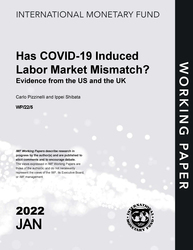
Has COVID-19 Induced Labor Market Mismatch? Evidence from the US and the UK
Has COVID-19 Induced Labor Market Mismatch? Evidence from the US and the UK
READ MORE...
Volume/Issue:
Volume 2022
Issue 005
Publication date: January 2022
ISBN: 9781616359027
$5.00
Add to Cart by clicking price of the language and format you'd like to purchase
Available Languages and Formats
| English |
Prices in red indicate formats that are not yet available but are forthcoming.
Topics covered in this book
This title contains information about the following subjects.
Click on a subject if you would like to see other titles with the same subjects.
Labor , Economics- Macroeconomics , Economics / General , Mismatch , Sectoral Reallocation , Labor Market Dynamics , COVID-19 , employment loss , labor market mismatch , vacancy share , COVID level , UK vacancy , Unemployment , Labor markets , Employment , Labor force , Global , North America , Global financial crisis of 2008-2009
Summary
This paper studies whether labor market mismatch played an important role for labor market dynamics during the COVID-19 pandemic. We apply the framework of S¸ahin et al. (2014) to the US and the UK to measure misallocation between job seekers and vacancies across sectors until the third quarter of 2021. We find that mismatch rose sharply at the onset of the pandemic but returned to previous levels within a few quarters. Consequently, the total loss in employment caused by the rise in mismatch was smaller during the COVID-19 pandemic than during the Global Financial Crisis. The results are robust to considering alternative definitions of job seekers and to using a measure of effective job seekers in each sector. Preliminary evidence suggests that increased inactivity among older workers, the so called She-cession (particularly in the US) and shifting worker preferences amid strong labor demand are more prominent explanations for the persistent employment shortfall vis-à-vis pre-COVID levels.
Copyright © 2010 - 2025
Powered by:
AIDC



